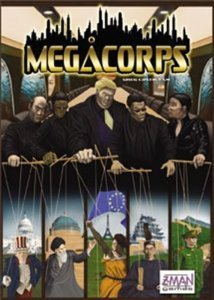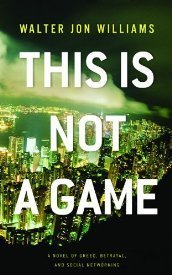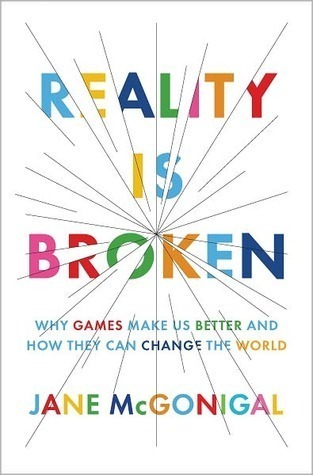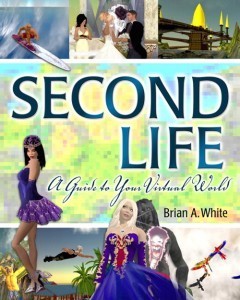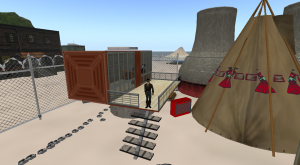Fran Ilich's Blog
February 2, 2013
Megacorps (a board game by Greg Costikyan)
By Fran Ilich <fran@eyebeam.org>
I bought the game because of its obvious relation to the cyberpunk genre and today’s global neoliberal reality hoping that some players would open their eyes to it without having to resort to heated political debate. The cover art also inspired me towards buying it: a couple of guys camouflaged with black suits (standard urban financier battle gear) puppeteering country symbols (Uncle Sam, the Ayatollah, Europa, a People Liberation Army Soldier) from the comfort of the island of Manhattan, specifically what it seems to be the outline of the Financial District of NYC.
It took me about a month to be able to play it, not for lack of trying, but because a minimum of 3 players are needed and its rules seemed to scare everyone away. Yet I stayed calm and on guard. Its not really the fact that its rules are hard to get, but it seems to me that the aspiring players of Megacorps need to grasp a few concepts and share a certain mindframe, if not be rightful open to certain possibilities of how global political economy operates. I am not saying it defeats the purpose, but my intentions with it it certainly was not to preach to the converted. So there you go, another challenge for me.
At the beginning one must choose between several culture-jammed corporations: the brasilian Globo media conglomerate that is known to hold hipnotized the population of its country with telenovelas, music, entertainment, sports (particularly soccer), as well as other corps like Nintendo, Nokia, Microsoft, Lenovo or Disney, that use distinct strategies of the same type. The holdings of our megacorporation will grow, and with it its interests and will soon include industries that might seem completely unrelated to the untrained eye. Depending on the corporation one chooses and random luck, players start by having control over a whole region: NAFTA, European Union, Mercosur, Great Russia, China, Japan, India, Asean, Caliphate, African Federation. Maghreb, Switzerland or the more fictional Asteroid and L-5. No dice are used in the game so from the moment the game begins till it ends, the goal of your megacorp is to use any tactics or strategies to control whole industries – for instance finance, oil, software, media, metals, food- across the world by eliminating competition, establishing cartels or any other means. To achieve this, you can take over countries through war, media, or what otherwise could be understood as sound business. However it goes you will soon see the world become a complex chess board with not enough room for all the megacorps playing, and how these try to extend their power to control a world that clearly has many forms of operating politically and economically, and that can’t possibly be managed by only one of them. However each of them aspire to to own the world by competing and distrusting its closest allies, even when pursuing cooperative paths. To make things harder national industries can be intervened by syndicalization or nationalization, countries can change politics from outright dictatorship, kleptocracy, democracy to the far more progressive wikisyndicalism.
If I were to describe the game in one phrase it would be: a global sophisticated 21st century version of Monopoly. It takes a few minutes and a little patience for anyone to become inmersed and passionate when playing it, and just as much to get soaked wet in its dystopic cyberpunk leftist concepts. I can only thank Greg Costikyan for designing such an amazing game, now I only hope he gets enough success that one day we get to enjoy a total sim experience designed by him.
January 28, 2013
This Is Not a Game (a book by Walter Jon Williams)
by Fran Ilich <fran@eyebeam.org>
This novel tells the plot that takes over the life of an alternate reality game producer who is in Southeast Asia, taking a break from work just weeks after finishing the biggest project so-far in her career. She is one of the lucky few to be able to make more than decent money on such nascent genre of narrative gaming as the ARG, and she is grateful for having landed such job in a company founded by 3 of her gaming buddies from back in college. However, what she experiences in Djakarta is something she never expected (her life gets tangled in what it seems, but isn’t an ARG): a currency collapse that devalues the Indonesian Rupiah and makes the prices on everything skyrocket. She is used to a strict diet of the latest in digital payments, the lowest-tech one being the credit card, and so, she is left out of the economic flow and has to survive with only a couple of rupiahs and maybe $200 USD in cash. Not enough to survive when trapped in a 5 star hotel. And so, while waiting to be extracted (rescued) by an operation contracted and planned by the company where she develops alternate reality games the fabric between reality and fiction starts to blur. Of course her company is used to stage situations like these, but even though they happen in the real world they are always part of actions that will only leave a mark on the world of players. But now all of this is being filtered into global media, and she finds out that the followers of Great Big Idea can respond to real life situations from the comfort of their mediated reality, as for them there is barely a distinction among both. And so while these follow the events, they have to remind to themselves every now and then: “This is not a game.”
While she awaits to be rescued, her boss and friend comissions her to design an even bigger alternate reality game to promote his latest investment: a mmorpg. And so she gets inspiration from the chaos where she’s inmersed, as Djakarta seems to fall down to ashes. And when she finally gets back to Los Angeles, she has to face and struggle the grim realities of marketing. Her boss wants to use the game to push several gadgets where he is a main investor in order to not lose money: a water-tester and decryption software. She on the other hand worries about losing street-cred and integrity as a designer. However this is the reality of the trade if the Alternate Reality Games genre want to raise to an industrial art level. And so, she has to experiment with creative accounting techniques to trick the corporation where she works, while at the same time all of them are being puppet-mastered (including she, the puppet-master) to allow some bots to continue with their financial speculation.
And so, the book could end up being just another entertaining and resourceful cyberpunk novel about the media of the day after tomorrow, but because of the remarkable description and emphasis it makes on the genre and profession of alternate reality games, and the lives of everyone involved: designers, producers, venture capitalists; describing the complexities of what a production unit would need for such an industry to bloom; showing all sort of intricacies with venture capitalism, mafias, information and technology industries, as well as unimaginable forms of feedback involving the subscriber base. When a game intertwines with real crime, economical, political and social situations, where do you draw the line between reality and fiction? And how? Isn’t this exactly the way in which historically the powers that be create narratives and ideologies to manufacture consent and furthermore, to materialize such consensual hallucination known as Absolute Reality?
This is not a game is recommended to anone who wants to either understand or run alternate reality games. The novel was written by Walter Jon Williams, an experienced player and designer of role playing games, specifically for Cyberpunk 2020 (Hardwired), and such thing comes very handy as the insights it provides not only include aerial view and first person shots, but it finds a special spot on the noble tradition of writers books on writing, one that could open the imagination of millions to new possibilities across narrative-media and games, much beyond the conventions of Hollywood films and videogame industries, but still in the much disputed battlefield where change in capital letters seems to occur: the mainstream. And this is not a minor thing, it brings hope and new blood while managing to design an alternate reality game which only exists in literature and written words.
December 28, 2012
Reality Is Broken: Why Games Make Us Better and How They Can Change the World (a book by Jane McGonigal)
by Fran Ilich <fran@eyebeam.org>
This book starts by bringing into our imagination the amazing shift that is happening in the material world as millions of persons all over the map decide to step aside from it to retreat and detach by immersing themselves into the virtual world of their preference. They may forget about following the regular paths of the American Way of Life, the rags-to-riches plots that some legends argue can be found in Vegas, Hollywood, Silicon Valley, Wall Street and so on. This has reached such epidemic proportions that at one point the People’s Bank of China had to intervene to prevent devaluation of the Yuan because too many renmibis were being converted and invested into virtual currency (in particularly the QQ coin), which the bank called “Coins of no return”. Its official comments were along the lines of the following: ”Once the company gets the money that people paid for the QQ coins, they can do virtually anything with it. They can invest in real estate or the stock market, without having to return a penny. It’s not just as if they are opening a bank – but the bank could possibly turn into a black hole.”
In any case, McGonigal refers to Mihaly Csikszentmihalyi’s concept of flow, which holds that, by playing or enjoying herself, any given person can achieve a state of joy that can remove her from her own regular limitations and take her into an unlimited moment of creativity. More or less, this is the general idea — and I have a hunch that we’re all familiar with the general direction of this argument. She goes on to tell a story that appears in the first book of Herodotus’ Histories: the Lidyans were suffering a serious food shortage that they couldn’t resolve. So, they decided to spend their time playing dice. This helped them forget their sad reality for 18 years, as they were less hungry because they spent their time playing. But McGonigal believes that games of today will not only allow us to hide from the grim realities of our present (neoliberal capitalism?), but can also help us focus jointly on creative solutions.
McGonigal goes on to describe what she considers to be the four traits of any game: goals, rules, a feedback system, and voluntary participation. Games, she says, immerse us in an experience that has the unconscious effect of making us concentrate and achieving more synapses than usual. As a result, something that would normally be hard work ends up being less difficult because we experience it as enjoyable and fun. McGonigal also makes a point to differentiate and explain different types of work, such as high stakes work, busy work, mental work, physical work, team work, and creative work. She believes that everyone can benefit from “eustress” (good stress) in order to achieve better results: happier endings create happier subjects and so on…
One example McGonigal offers: David Sudnow wasn’t having much success in his regular job as a musician; he was also addicted to the Atari game Breakout. He went on to write the first book account of a videogame, which is the classic Pilgrim in the Micro World. McGonigal uses this example to argue that depression could be a physiological indicator that the road being folowed is a bad one; depression is a way in which the body itself stops us from heading into trouble. (She also brings our attention to New Games (1977) by the New Games Foundation, as another classic texts in the field.)
McGonigal describes churches, pyramids, and other monumental institutions as social organizations that are the result of co-operative labor. She believes that games could be organizational and about life management, and that clues could be used to assign tasks.In general, she is drawn towards what could be described as “life-improvement” games, which can be played through all sorts of methods such as videogames, cards, larping, or alternative reality playing. Overall, she insists that players should feel invested in their virtual or game worlds and have long-term goals within them. Content generated from games becomes a reward in itself. This is content, she suggests, is like so many puzzle-pieces that are assembled through the co-operative labor of gaming: ”Until players put a chaotic story together it doesn’t really exist -it’s just a web of evidence, the raw materials for a story: it’s up to the players to do the actual final storytelling, which typically occurs on a wiki that ultimately represents an “official” story of the game.
Of course, McGonigal is able to draw on her own exceptional expertise, as she is the designer of an impressive amont of successful games. These include her invention of a “lost” ancient Olympic sport and the falsified history around it, which managed take on a life of its own after it was first “resurrected” at the Beijing Olympics. McGonigal was chosen as one of the “Women to Watch” who are changing industries (and the way we think) in the last issue of Entrepreneur magazine, alongside minds such as Limor Fried (of Adafruit fame) and Tara Hunt (The Whuffie Factor).
I’ll close this review with what I find to be one of McGonigal’s most provocative suggestions: “And finally, as the Llydians were so quick to realize, games do not rely on scarce or finite resources. We can play games endlessly, no matter how limited our resources. Moreover when we play games, we consume less. We are just starting to realize this possibility ourselves today, we are starting to question material wealth as a source of authentic happiness.”
I was game to such ideas before opening this book. In my case, however, it’s the result of a certain exasperation with so many trends in digital activism that seem to celebrate themselves and supercede each other in such rapid succession that the absence of any greater strategy is hardly noted.
September 20, 2012
A Conversation With My 12 Year Old Self (a Youtube film by Jeremiah McDonald)

by Fran Ilich <fran@eyebeam.org>
In A Conversation With My 12 Year Old Self Actor and director Jeremiah McDonald, who has been uploading videos into Youtube dealing with some of his obsessions — animation, Dr. Who, Youtube, and, more specifically, his narcissistic self –found among his old VHS tapes footage where his 12 year-old self talks about his desire to interview the then-future (and now present) Jeremiah. By doing creative editing he is able to pull the trick off alright — better, at least, than many of those “same actor, twin brothers” movies of past times that in general fell short of bad slapstick comedy. He uses the card by combining it with a sort of media flashback time travel resource, which making aside the fact that is the Dr. Who main topic (and so, another of the coded winks he does) gets picked up on Youtube not so much because of the cult aspect, but for the more widespread practice of corniness among the platform users. However, McDonald is able to update the trick in a fashion that already generated him 8,412,786 views, and possibly some tangible cash or opportunities, beyond being reviewed on Entertainment Weekly and tweetted by notable people like Neil Gaiman and Roger Ebert.
In any case, we realize two things about Jeremiah: he was a much better actor as a kid and he has joined our beloved army of dilettantes (he wanted to get into animation, but ended up trying to do film because it was much easier). All in all, besides the found footage, I discovered that a previous video of Jeremiah’s is much more interesting. In “YouTube Is My Life” (where we find out that Jeremiah can sing), which had 2,013,430 views at the time of posting this text, he is someone trying to get even with the network by spreading some viral negativity. It shows that his videos are clearly the product of an actor (himself) who displays his multiple talents as wares for sale (but who can’t structure a story). Like in the previous video, Jeremiah makes the storyline depend on his palette of abilities he can offer as a professional, making this emerging genre of the web 2.0 “one man act” an even more attractive trend for aspiring actors, directors, and other man-orchestras swimming on the web social networks: show what you can do for show business and make it a satellite, hoping the forces of gravitation can get you a gig somewhere in the galactic federation. All the luck, Jeremiah. In time we trust.
July 5, 2012
The Eternal Sunshine of the Spotless Mind (a film by Michel Gondry)
by Fran Ilich <fran@eyebeam.org>
That morning he ditched work to go to Montauk. He was not an impulsive person. That’s how we start descending into the irremediable collapse of two galaxies: one, a boring guy (played by Jim Carrey), who is emotionally immature and lives life as any other Brooklyn romantic novelist: with an inner soundtrack and a voice-off no one else (but the audience) can hear; and the other, an emotional blender of a girl (enacted by the beautiful and charming Kate Winslet) who gravitates towards the most intense emotions urban life allows workers, commonly known as the Road to Self-Destruction. She changes hair color as much as she can. He is afraid of jumping into the abyss and is, in general, just full of shit. And she’s the kind of girl who can overload anyone and who doesn’t have a clue as to what she wants. But in the meantime, she’s ready to overturn the city, taking all the hostages she can. Him. She’s ready to destroy anyone’s life if that’s the price to pay. And his movie is about the destruction of his life. Until she decides it’s too much and erases him out of her brain: technically, she chooses brain damage because she doesn’t want him in her life and presumably, to slowly forget him would mean letting him use too much space in her mind. Maybe if she charged him brain web hosting there wouldn’t be any problem — but not for free. Both are as lonely as any other soul in NYC.
“You look at a baby and they are so clean. Adults are just a mess of sadness and phobias.” So yes, fortunately, in this amazing piece of fiction written by Charlie Kauffman, white New York City was able to surpass the pricey and time consuming Lacanian therapy and replace it with the more cost-effective practice of a fringe scientist who is experimenting with memory and its destruction – deleting all those unwanted bits, which turn out to be so numerous that patients become addicted to the treatment, neurotically removing every unpleasantry. Hell is others, as Jean-Paul Sartre wrote a long time ago. Watching the movie, I couldn’t but wonder why do women work so hard constructing men like us, if women won’t like us once we become adults. What kind of matrix of relations and desires have we built? And why does society cause so much pain in individual psyches, starting right from the time one is born? Maybe it’s the only way society can reproduce from generation to generation in order to continue existing. And so, in the film, it takes the emotional breakthrough of a scorned secretary (Kirsten Dunst) to steal patients files’ in order to liberate them. We get the idea: emotions and persons are there to be experienced and lived.
I am not a project, she says. I’ll get saved and I’ll feel trapped cause that’s what happens to me, he says. But everybody’s gotta learn sometime, everybody’s gotta learn sometime. Its an amazing movie, but I don’t recommend seeing it more than one time: its effect might only work once.
July 4, 2012
The African Queen (a film by John Huston)
By Fran Ilich <fran@eyebeam.org>
“I never dreamt a mere physical experience could be so stimulating,” says Rose Sayer (the character played by Katherine Hepburn) somewhere around the middle of the movie when she discovers the excitement of river boating and love with an unlikely partner: James Allnut, a sweaty and simple Canadian miner whose stomach gives him away with its terrible grunting noises, played by none other than Humphrey Bogart.
Rose used to be the pianist in a Methodist church in German East Africa for a crowd of non-English speakers who didn’t want to be baptized and didn’t care to follow the lyrics of Stille Nacht and instead sang whatever other thing they liked. But then her brother, the priest of the church died, victim of a panic attack after the Germans burned their village to the ground. The siblings, being British had everything to lose in such a country during such a war but, fortunately for Rose, James Allnut (H. Bogart) comes to her rescue and she is easily able to impose her will and manipulate him by what could be described as some sort of imperial Commonwealth seigniorial patriotism, where she being British and clearly urban, could command the poor uneducated Canadian into following her worst whims.
Rose’s escape plan was everything but likely to succeed. She wanted to escape the German-occupied country by taking a small steam boat (The African Queen) through rapids and past German forts, with the goal of destroying a war vessel with nothing more than improvised self-made torpedoes using leftover materials, while betting their lives on the conviction that God is on the side of the British royal crown.
Whereas Bogart’s character is superb, Rose is well described by Allnut’s apt insult as a “crazy psalm-singing skinny old-maid.” The peak of the movie for me was a photogram of tens of gin bottles floating in the river after she emptied them in a bold disciplinary move, and the fact that Germans are portrayed as humans and not the robotic fanatics Hollywood has taught us to hate over almost a century of cinema. As a general appraisal I would say The African Queen is a claustrophobic movie whose only drop of fresh oxygen is the river and fauna of Uganda (hippos, crocodiles and so on, that are better enjoyed in any other boring nature documentary), and Bogart himself. So to sum it up: don’t watch it if you don’t have to, or if you are not a fan or a student of Bogart, Hepburn or director John Huston.
July 3, 2012
Second Life: a guide to your virtual world (a book by Brian White)
By Fran Ilich <fran@eyebeam.org>
Upon logging into the virtual world for the first time one can’t possibly imagine how one’s own first life will change if the SL virus catches on and manages to reproduce: the dramas and joys don’t stay virtual, they can easily take over real life. Brian White’s book could almost be a life manual or a guidebook for successful living, even the equivalent of a Lonely Planet for Second Life, except that he manages to successfully leave most anthropological, cultural, economical, political and social questions wide open (for one’s own experience to define), while still hinting at the better known subcultures and complexities one can find in-world.
One of the first things White’s book addresses is that Second Life lacks a defined goal. He argues that this makes the platform as open-ended as real life, thus managing to distance itself from traditional video games and MMORPG, though it still allows any group to develop its own, as long as there is no substantial use of Artificial Intelligence. In this sense, SL can be more like an engine, or can end up as loose as a 3D-enabled chat room for humans hiding behind avatars. Or it can be a world to explore, even a place where one can practice activities one can’t do in real life. Or simply a place for business.
White delves into the history, politics and government of SL, and introduces us to renowned avatars (or simply acquaintances of his) that give tips and tutorials, or give interviews on all sorts of SL-related things: comparison between virtual worlds, social relations, money, building basements and houses, scripting, etc. The book also has chapters on how to properly control the avatar: from movement to communication, gestures and animation, clothing design, and the basics for building under the Linden Lab’s Prim system, which differs from Maya. It also provides info on land for those interested in either buying or renting, or those who want to get into community management by way of the business of virtual real estate. And last but not least, White offers a primer on photos, music and machinima (movies that use avatars as actors) for those who want to have a virtual career in the industrial arts.
Second Life: A Guide to Your Virtual World is true to its motto: “Live your Second Life to the fullest!”and I recommend it to any beginner or intermediate user who wants to upgrade his or her experience to a level beyond what Premium offers – and for only half that price. The only drawback of White’s book is that it dates from 2007, but then again, Second Life is by no means a new kid on the block, so if you’re looking for a new trend along the same lines then I can only recommend you to find your second life within Facebook’s App Cloud Party: that’s a story yet to be told.
July 1, 2012
Second life, Third Life economic practice and my third of a life
by Fran Ilich <fran@eyebeam.org>
I logged into Second Life at the beginning of 2007, somehow around the web 2.0 rush wondering what was behind the hype of a web 3.0. And remembered not being too attracted by it, no matter how hard my overclocked computer and I tried. The reasons were simple: in the 90s I came to the conclusion that VRML was missing the mark completely on where the Internet should go: virtual reality as cyberpunk novelists envisioned it hadn’t happened and the Web, Usenet and even the BBS were much closer to Cyberspace when it came to what counted: “A consensual hallucination experienced daily by billions of legitimate operators, in every nation, by children being taught mathematical concepts… A graphic representation of data abstracted from the banks of every computer in the human system. Unthinkable complexity. Lines of light ranged in the nonspace of the mind, clusters and constellations of data. Like city lights, receding.” Thanks again, Gibson.
The other reason was, I felt by being a mac-user in Mexico City I had missed my moment for MMORPG, and although I had been very attracted to Everquest, it arrived too late to the Mac and the one time I could have bought it I ended up passing the opportunity, not to mention that Active Worlds has been a Windows-only universe. And so, when Second Life peaked I felt my space in Cyberspace was somewhere else, yet I opened an account like millions more to be in tune and aware of the Zeitgeist. For me the experience was like being in a 3d version of a chat room server, with infinite possibilities to meet bored teenagers, to endlessly start conversations with avatars wearing deceiving bodys, and to fight back the force of a vacuum luring you into spending hard-earned pesos to be converted into USD and then Linden Dollars just to buy virtual goods, while outside of the Second Life virtual world, the Internet was somehow heading into an unknown direction: some corporations fighting to abolish net neutrality, countries pushing to have it nationalized, and many people taking the path of Creative Commons & information sharing, while struggling to find brokers who could monetize their labor a la Google Adsense, in order to find means for substenance and a political economy outside of corporate labor. And in the meantime Second Life had already created its own private money, a currency that could only be used within its networks but that it was being traded and creating the first virtual billionaires like Anshe Chung, who was pushing further Linden Lab’s concept of social life (one not unlike the one lived by the global suburbanite families of The Sims).
So during the week of Berlin’s Transmediale in 2007, Pit Schultz and I wrote a manifesto about Networked Theatre of the Opressed and organized an event within Second Life, with the participation of Diana Mccarty and other Nettimers. And then rapidly moved on. Enter 2011 when I arrive to Eyebeam and was asked during the interview the same question I’m always asked: Is the Diego de la Vega cooperative media conglomerate a game? Is it virtual? Is it on Second Life? And I had to explain that it actually only used the Internet as a tool, and that other than that it was focused on material conditions through the use of that blurry abstraction known as money. And a few weeks later when I came back to sign my contract, I stumbled upon The Second Life Herald: The Virtual Tabloid that Witnessed the Dawn of the Metaverse by Peter Ludlow and Mark Wallace (it was a recommendation by Roddy Schrock), and the book actually made me consider using Second Life, but I quickly blocked the impulsed and opted for the idea of using OpenSimulator. But in the end I used neither and only adopting the language by describing it like this: “Diego de la Vega™ it’s a coin-operated cooperative media conglomerate where real people work a thirdlife, creating a virtual industry thru network connections in order to produce material results in the real world”. A description I would use when talking to outsiders, curators and potential new investors of Spacebank (someone offered to invest her trust which was 1M+, and a writer who was researching alternative currency was also interested in investing an important amount). I also noticed that when I explained the nano-macro-economy of the Digital Material Sunflower as if it was a game, people in the USA were more inclined to like it, something that ended up costing me a few discussions and even a customer, with people already involved in the DMS nano-macro-economy and who thought of what they were doing as social activism (if not directly economic insurgency), and were not keen to become players of any kind of game or simulation. Where as for me, it was just words, as both descriptions offered the same results when actions were performed correctly. A little after this, I took part in a panel organized by Dr. Henry Jenkins, where I presented the project for the first time as a digital material virtual world. And then by the end of 2011 it seemed to me that the Internet at large had become fully virtual, portraying a reality that was operating in a game of mirrors that oftenly confused what happened within networks like Facebook with life in the global streets. Right then I decided to become absent a la Don Quijote of earlier times and got lost in a virtual world instead of diving into Occupy Wall Street (even as much as I felt attracted and distracted by its banking project to which i own the domain name): waiting for the moment to become material again and fight back just as the Old Man from Los Altos. In the meantime Diego de la Vega co-op inmersed itself in Second Life using my old 2007 avatar: in any case its numbers were already telling stories and weaving an own narrative of engagement and relations, and so to play a little Alternate Reality Game loosely based on Cyberpunk 2020, could be the basis for fresh oxygen and maybe even new blood for tactical and pragmatical utopian action. And so, little by little, I became addicted and it became harder for Diego de la Vega co-op to focus on its actual Real Life missions until it decided to kickstart its Partido CyberPunk initiative in order to have a proper Central Committee within Second Life. After that came an investment fund focused on Virtual Real Estate that would allow the co-op corp to develop an in-world utopian community and continue working within the secret agenda of Another World is Possible, while having any cash excedents invested into either a slow money or solidarity agriculture fund. And so our bittersweet third life goes on.
January 1, 2012
Offer on virtual real estate mortgage-backed securities.
Dear Spacebank Customer,
How are you? We hope you are celebrating yet another year of NAFTA and the anniversary of the rising of the Zapatista National Liberation Army.
I am writing, as you might be interested in buying titles of the Virtual Real Estate Mortgage Backed Securities, a loan which was used to build Casa Dandelion, the safehouse in 2L of the cooperative media conglomerate Diego de la Vega. The cost per title is 1 Digital Material Sunflower. So take the opportunity to start the year with your left foot by supporting the construction of the Partido Cyberpunk, an international conspiracy that researches technologies that are creative, disruptive, emancipatory and hybrid, and which might function to build communities, spaces, networks of utopic life that can lead towards another possible world. But which in game reality will be a campaign of Cyberpunk 2020, even if it will have material results in the nano-macro-economy of the DMS. Who says games can’t be real? Even if they are really virtual, nothing stops them from being material: its the network economy, stupid!
From now on, Diego de la Vega will be an avatar in cyberspace, a cooperative media conglomerate like those in cyberpunk novels, and an entity where many social relations intersect: an economic function in itself, which will now be temporarily connecting the economies of the Digital Material Sunflower with the Linden Dollar. This in part because we have observed that such digital currency is relatively stable and basically convertible, but also to experiment with a next phase towards the construction of a net.island. That is, if in the cities there is an emergence at impressive speeds, of zones and experiences which can only be accesed thru augmented reality and internet, and every day that passes by, clothes are becoming integrated to technology, so we believe it might be an important exercise to research a virtual world like Second Life, but only as a complementary activity. We outsource our thirdlife to be able to create network connections that make an impact in material reality, so we could only try Second Life to see if it makes sense to think of the existence of a virtual reality net.island. And in the worst case scenario, if we find virtuality can work for us, but not 2L, we can always move to Opensimulator with the plus of new found experience of 2L. If the knight novels of Amadis de Gaula helped ‘materialize’ a ficticious (but very real) state like (and also helped to inspire Cervantes to write his famous 400 year old novel), where Diego de la Vega fought colonizers within fiction, and today the economy of Hollywood is nurtured with the labor of migrant human workers without political rights which make possible material and virtual realities. We would have to find out if SL can help us materialize an island, a little utopia that within fiction can get us closer to our goals. And if everything works out, next june in Ecuador, Diego de la Vega will become a legal body, linking the Digital Material Sunflower with the Sucre Digital, which is the digital currency of the ALBA countries: Bolivia, Cuba, Ecuador and Venezuela. Maybe from our little corner of the Internet we can, in fact, collaborate, change the material reality by generating creative flows from experimental economics and finances, hacktivism, and narrative media.
Happy new year!
Fran Ilich.

